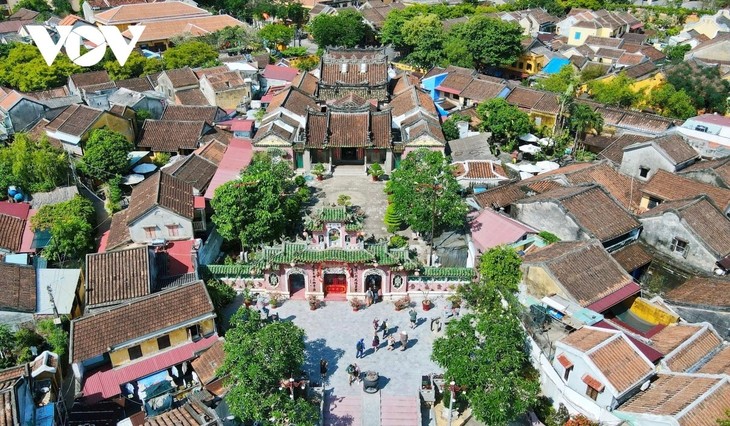Hoi An ancient town, renowned for its tranquil beauty, is the gem of the central coast province of Quang Nam. Hoi An was recognized as a UNESCO world cultural heritage site in 1999. In the 25 years since then, the government and residents of Hoi An have preserved their living museum of architecture and lifestyle and sustainably developed that heritage.

An aerial view of Hoi An ancient town. (Photo: VOV)
Hoi An, which was founded in the 16th century, became one of the region's busiest trading ports. Merchants from China, Japan, the Netherlands, India, and Spain came here to trade. Consequently, the architecture and culture of Hoi A reflect a convergence of East and West. Today Hoi An has a serene and contemplative atmosphere. It impresses visitors with its moss-covered rooftops and ochre-colored walls.
Hoi An boasts 27 nationally recognized relics, including nine within the ancient town, which has been recognized as a special national relic and deemed by UNESCO an exceptionally well-preserved example of a traditional Asian trading port and an outstanding material manifestation of the fusion of cultures over time in an international maritime commercial center.
“25 years after UNESCO’s recognition, Hoi An has managed to keep its architectural structures intact, and has significantly contributed to tourism development in Quang Nam province,” said Nguyen Thanh Hong, head of Quang Nam province’s Department of Culture, Sports, and Tourism.
Hoi An has boosted employment and gotten local people and businesses involved in preserving and promoting the town’s heritage, said Hong. “Its model has been acknowledged by UNESCO as a successful example of leveraging heritage for development while ensuring conservation.”
Hoi An is a living museum of architectural heritage and a vibrant cultural space. It has six craft villages practicing 50 traditional crafts, such as Thanh Ha pottery, Kim Bong carpentry, and Tra Que vegetable farming.
Being designated a World Cultural Heritage Site has motivated Hoi An to preserve its centuries-old craft villages and its distinctive customs and folk arts, including the Lantern Festival, the Mid-Autumn Festival, and Bai Choi singing. These intangible heritages have become popular tourism products that attract large crowds of domestic and international tourists.

Carpenter Huynh Suong creates a wooden statue of the Goddess of Mercy. (Photo: VOV)
"Hoi An has retained its ancient charm. It’s a complex of relics and culture which is worthy of being cherished and preserved for future generations," mask-maker Bui Quy Phong said.
“It’s important to preserve the culture of the traditional craft villages, which are unique elements of Hoi An. Each craft village has its own distinctive style and unique products imbued with the cultural identity of Hoi An,” said carpenter Huynh .
While preserving its traditional values, Hoi An has also embraced industrial development. It has built strong relationships with cities in Germany, Japan, South Korea, Hungary, and other countries.
"International collaboration in conservation has been a priority. Hoi An has established connections with numerous international organizations and twinned with cities worldwide. These activities have provided resources for conservation efforts and increased the local staff’s capacity to manage and promote heritage values," Nguyen Van Lanh, Vice Chairman of the Hoi An People’s Committee, said.
Hoi An is regarded as a model for heritage conservation and promotion, thanks to cooperation between local communities, businesses, and authorities. The Quang Nam provincial People’s Committee has developed a project to make Hoi An an eco-cultural-tourism city that preserves its identity while effectively harnessing the economic potential of its heritage.
Hoi An intends to expand its international collaboration in heritage conservation and aspires to become a leading cultural-ecological tourism hub by integrating digital technology into its heritage management and tourism.